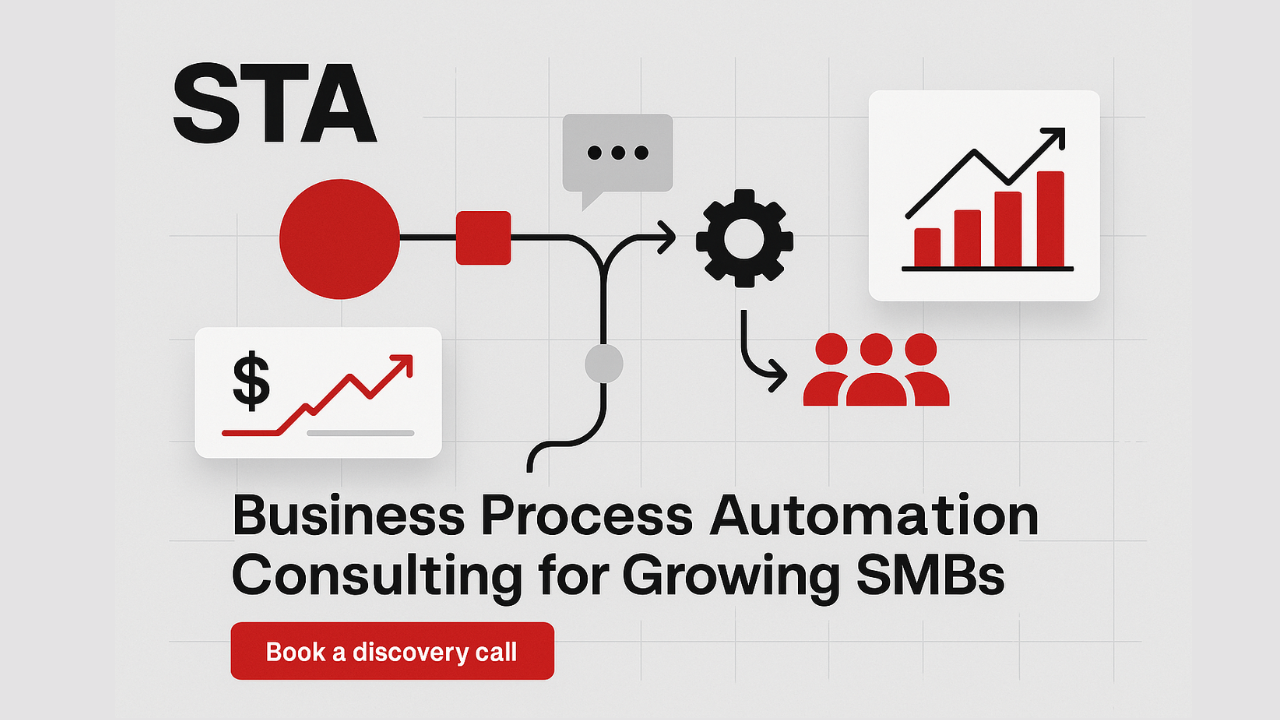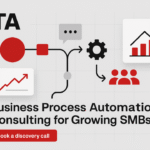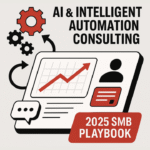Executive Summary
Manual processes quietly drain 30–40% of team capacity through repetitive tasks, duplicate data entry, email‑based approvals, and disconnected systems. For SMBs and mid‑market firms, that translates into higher costs, slower execution, and stalled growth. Business Process Automation (BPA) consulting solves this by redesigning workflows end‑to‑end and orchestrating the right technologies across your current toolset. STA’s approach combines process strategy, human‑centered change management, and implementation to deliver measurable ROI in 6–12 weeks — without forcing you onto a “one‑tool‑fits‑all” platform.
Who this playbook is for: founders, COOs/CFOs, operations leaders, and functional heads (Sales, Finance, CX, Ops) who want fewer manual tasks, faster cycle times, cleaner data, and executive‑level visibility.
What Is Business Process Automation Consulting?
Business Process Automation consulting is the structured practice of analyzing, simplifying, and digitizing core business workflows so teams can execute faster with fewer errors. It goes far beyond “installing an app.” BPA consulting:
- Maps how work actually gets done today (people, systems, handoffs, and decision points).
- Eliminates unnecessary steps and standardizes best‑practice paths.
- Orchestrates automations across your existing software (CRM, finance, operations, communications) to reduce manual touches.
- Implements controls, governance, and reporting so processes are consistent and auditable.
- Coaches teams through adoption so the new way of working actually sticks.
Why 2025 Demands a Process‑First Approach (Not a Tool‑First One)
Most companies tried “DIY automation” by turning on features inside individual tools. The result: fragmented workflows, shadow spreadsheets, and automations that break with every handoff. In 2025, the winners are taking a process‑first approach — redesigning how work flows across the business, then using lightweight automation to implement it. That’s the difference between automating chaos and scaling with confidence.
Signs You’re Ready for BPA Consulting
- Email is your workflow engine. Approvals, updates, and handoffs live in inboxes and get lost.
- Spreadsheets as systems. Critical work depends on manually updated sheets that few people truly understand.
- Rework and status meetings. Teams chase information and recreate work already done elsewhere.
- Data disagreements. Finance, Sales, and Operations tell different truths.
- Onboarding pain. It takes weeks for new hires to learn “how to get things done here.”
- Compliance risk. No audit trail for who approved what, when, and based on which data.
If two or more apply, BPA consulting typically pays for itself within the first quarter of adoption.
Outcomes You Can Measure (Typical 6–12 Week Wins)
Across quoting, onboarding, billing, and support.
Standardized, automated handoffs.
Single source of truth with validation.
Role‑based dashboards for leaders.
Repetitive work disappears; ownership is clear.
Example: A hospitality group cut group‑booking turnaround from 5 days to 36 hours, while finance reduced month‑end close by 3 days through automated reconciliations and approvals.
STA’s BPA Consulting Methodology
1) Discover & Diagnose (Week 0–2)
- Stakeholder interviews, work‑shadowing, and artifact review (emails, sheets, SOPs).
- Current‑state process mapping (SIPOC + swimlane views).
- Baseline metrics: volume, cycle time, handoffs, error/rework rate.
2) Redesign & Prioritize (Week 2–4)
- Future‑state blueprint: simplified paths, decision rules, data model, and controls.
- Prioritized backlog scored on Impact × Effort × Risk.
- Change‑plan: RACI, enablement, and communications.
3) Implement & Orchestrate (Week 4–10)
- Iterative sprints delivering working automations each week.
- Connectors and APIs link your existing systems; we avoid platform lock‑in.
- Guardrails: logging, alerts, exception queues, and rollbacks.
4) Adopt & Scale (Week 6–12)
- Playbooks, role‑based training, and hypercare.
- Governance rituals: weekly ops review, monthly process health, quarterly optimization.
- Handover with documentation, test suites, and roadmap for phase two.
Where BPA Delivers Fastest ROI (High‑Leverage Use Cases)
Revenue Operations & CX
- Lead capture → qualification → routing → follow‑up.
- Quote‑to‑cash: proposals, e‑sign, invoicing, collections nudges.
- Support triage, SLAs, and customer notifications.
Finance & Back Office
- AP/AR matching, 3‑way checks, approvals, and reminders.
- Revenue recognition checkpoints and month‑end close workflows.
- Vendor onboarding, W‑9/KYC collection, and contract renewal prompts.
People Operations
- Hiring pipelines, background checks, device/app provisioning, and 30‑60‑90 day plans.
- Time‑off approvals, payroll adjustments, and policy acknowledgments.
Hospitality‑Focused Examples (STA Specialty)
- Group sales workflows: inquiry → availability → dynamic pricing → proposal → contract → deposit.
- Housekeeping dispatch and room‑status sync across PMS and ops tools.
- Event orders (BEOs), cross‑department checklists, and real‑time change logs.
Other Industry Highlights
- Property management: resident onboarding, maintenance triage, rent collection exceptions.
- Accounting firms: client intake, PBC lists, reconciliations, and deliverable reviews.
- Retail/eCommerce: catalog sync, inventory thresholds, returns logistics, and RMA tracking.
Tooling Philosophy: Orchestrate Your Existing Stack
We design automations around the systems you already use (CRM, ERP/finance, HRIS, service desk, messaging). Where gaps exist, we incorporate lightweight services or build slender, well‑documented connectors. We avoid name‑dropping specific platforms and never push a proprietary “silver bullet.” Your architecture stays flexible and vendor‑neutral.
Data, Controls, and Risk Management
- Data model first. Define canonical records and field ownership before building flows.
- Controls woven in. Segregation of duties, approval thresholds, and audit trails baked into the process.
- Observability. Logs, metrics, and alerts show what ran, when, and why.
- Security & privacy. Least privilege, vaulted credentials, and role‑based access.
Change Management That Actually Works
- Why now? Tie every change to tangible pain points and wins for each role.
- Right‑sized enablement. Micro‑videos, one‑page playbooks, and live office hours.
- Champions network. Power users provide feedback and peer support.
- Measure what matters. Adoption dashboards: usage, exceptions, and time saved per team.
Engagement Models & Timelines
- Diagnostic Sprint (2–3 weeks): Current‑state mapping, future‑state blueprint, ROI model, and 90‑day roadmap.
- Pilot Program (6–8 weeks): One high‑impact workflow automated end‑to‑end with training and metrics.
- Scale Program (Quarterly): Rolling sprints across functions with governance and change management.
Typical leadership time commitment: 60–90 minutes/week for reviews and decisions.
Measuring ROI (and Proving It)
We baseline before we build. Each initiative tracks:
- Cycle time from trigger to completion.
- Manual touches per case (target: −50% or better).
- First‑pass yield (errors/rework).
- Throughput and SLA attainment.
- Financial impact (cash acceleration, cost per transaction, cost to serve).
Results are summarized in executive dashboards and shared at monthly ops reviews.
FAQs
- Is BPA consulting only for large enterprises?
- No. SMBs and mid‑market firms often see the fastest ROI because a few critical workflows touch most of the business.
- How long does it take to see results?
- Most pilots deliver measurable improvements within 6–8 weeks. Broader rollouts typically occur over one to three quarters.
- Will we have to switch platforms?
- Not necessarily. We start by orchestrating the tools you already pay for and only add components where there’s a clear gap.
- What if our processes are messy?
- Perfect. That’s why BPA consulting exists. We simplify first, then automate — not the other way around.
- How do we maintain automations after launch?
- We provide documentation, test suites, guardrails, and training so your team can own day‑to‑day operations, with STA available as an escalation partner.
Getting Started with STA (Next 14 Days)
- Day 1–3: Leadership alignment call and data access checklist.
- Day 4–10: Discover & Diagnose sprint (interviews, mapping, baselines).
- Day 11–14: Future‑state blueprint, prioritized backlog, and pilot plan.
Deliverables you can expect: process maps, data model, controls plan, ROI model, enablement outline, and a working pilot scope.
Ready to Reduce Manual Work and Scale with Confidence?
If you’re ready to reduce manual work, accelerate cycle times, and build an operations engine that scales, let’s talk.
About Scale Through Automation (STA)
STA is an automation consulting partner for SMBs and mid‑market leaders. We combine process design, change management, and implementation to help businesses eliminate manual work, improve data quality, and scale with confidence — without vendor lock‑in or tool sprawl.




